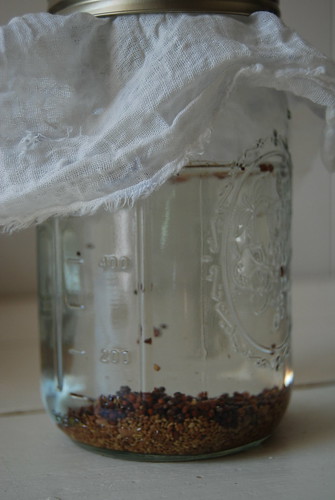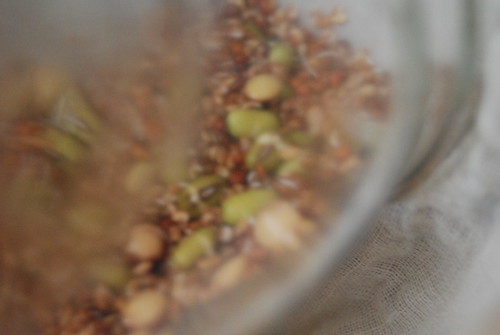As much as I'm sure everyone would like to be done with every last bit of the cold weather, this transition won't happen as quickly as we would all hope. But this time of year something changes every day. The sunlight is more abundant, there are more birds singing in the early morning. Hardy bulbs sprout their tiny flowers, buds begin to swell -- change is evident, even as it seems like winter is slow to leave. Its still well below freezing at night and fairly cool during the day, but I have been thinking a lot about planting at the community garden. I guess its hard to be patient and spring doesn't even officially begin until later this week.
All winter I have been wanting to do some sprouting in my kitchen and finally last week I started the process. I had forgotten how simple it is to do, and after the process began I was annoyed that I hadn't been doing it all winter. Its a great way to have some homegrown veggies when the ground is still frozen and local greens are hard to find. I think this is a good time of year, though, to grow sprouts. When it begins to feel more like spring, I always wish for lighter greener foods and since I can't buy these locally in March this is the perfect time to begin growing some.
Perhaps the idea of growing sprouts seems absurd considering that they aren't particularly hearty, filling or gourmet. But sprouted seeds are a simple way to grow some of your own food, even in cold weather and they have a crisp, earthy taste that is great in salads, sandwiches or a stirfry.
There are a variety of seeds that are good for sprouting. Radish, broccoli, alfalfa, and mung beans all make good sprouts. You can also get sprouting mixes and all of these can usually be found at natural foods stores. In addition to seeds you will need a quart sized jar with a piece of mesh (such as cheese cloth) that will cover the top and can be held securely in place with a jar lid or rubber band.
Add two or three tablespoons of seeds to the jar and fill with water. Cover the top of the jar securely with the screen. Rinse the seeds and then cover with water again. Let the seeds soak like this overnight. The next day, pour the water out of the jar (without removing the screen). Place the jar upside down in a bowl so the remaining water can drain.
Rinse the seeds at least twice a day, or more if needed. The seeds (which will begin to sprout in a day or two) should not dry out, but they should not be too wet, either. I find that cooler months are best for sprouting because the seeds don't dry out too much and they stay fresher as they begin to grow.
Continue rinsing the seeds for a few days. Its best to keep the jar in the bowl someplace out of direct sunlight or high heat. I keep mine near the kitchen sink so I don't forget to rinse them and they get some indirect light so they are greener.

The sprouts are ready when they are about half- to one-inch long. At this point I dump them out of the jar into a bowl of clean, cool water and give them another rinse. The seeds which didn't sprout will sink to the bottom, although its okay to eat those, too. Sprouts are best eaten when they are really fresh, and should be stored in a container that doesn't keep them too wet or compact them too much.


The sprouts are ready when they are about half- to one-inch long. At this point I dump them out of the jar into a bowl of clean, cool water and give them another rinse. The seeds which didn't sprout will sink to the bottom, although its okay to eat those, too. Sprouts are best eaten when they are really fresh, and should be stored in a container that doesn't keep them too wet or compact them too much.





No comments:
Post a Comment